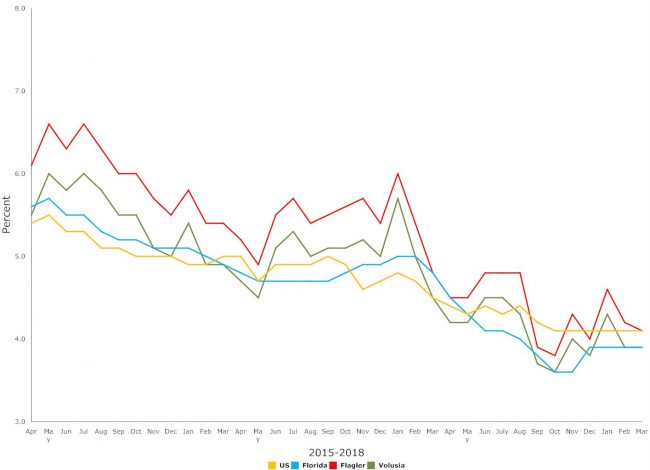
Some unemployment reports brim with exciting numbers–lower unemployment rate, surge in labor force or people with jobs. Flagler and Florida’s March unemployment report is not among them. The numbers are in a holding pattern almost across the board.
Flagler’s unemployment rate is at a healthy 4.1 percent, where it’s been, give or take a few decimal points, for seven months. The local labor force, an indication of working-age population trends, fell by about 200, to 46,841, falling to within 300 of where it was a year ago. That’s not alarming after surges at the beginning of the year that set new historic highs for the county’s labor force as well as for the number of people with jobs who live in the county. That number fell in March marginally, to 44,902, almost 600 higher than it was a year ago. A few dozen people got off the unemployment rolls in the past month, lowering the number of local unemployed to 1,939.
Florida’s unemployment rate in March remained at 3.9 percent for the fourth month in a row. It had bottomed out at 3.6 percent last October and November before creeping back up. The national unemployment rate has been locked in at 4.1 percent since October, which means that in both the nation and the state, the economy has been strong enough to absorb new entrants into the labor force, but not more. To some economists, the 4 percent unemployment zone represents so-called “full employment,” because at any time, a portion of the workforce is legitimately between jobs, some industries are always laying off, and new entrants into the workforce don’t necessarily find the jobs they want immediately.
There were 400,000 unemployed Floridians in March in a labor force of 10.2 million. (The state’s population is 21 million.) Florida’s economy created 13,800 net new, non-agricultural jobs in March, for a total of 173,000 new jobs over the year. As always, Gov. Rick Scott in his announcement today mentioned only the 12,500 private sector jobs that were added to the rolls, ignoring workers in the public sector–essentially suggesting that their jobs are not as worthy of notice as jobs in the private sector. Those jobs include those of teachers, cops, firefighters, EMTs, public utility workers and the like. State and local governments combined for 1,400 new jobs. There was a decrease of 100 federal jobs.
“I’m proud to announce today that Florida has achieved another incredible milestone – 1.5 million private-sector jobs have been created since December 2010,” Scott said in a statement. “This incredible turnaround should serve as a blueprint for the rest of the country. If you cut taxes, eliminate burdensome regulation and invest in the priorities that matter most to families, like education, job creators respond by growing and creating jobs. Congratulations to every business who has chosen Florida as the best place to create jobs.”
The job numbers don’t distinguish between full and part-time work, nor do they reflect the quality of the jobs. Florida relies heavily on low-paying, no-benefit, part-time jobs. The federal government’s alternative measure of employment, under-employment and unemployment places Florida’s unemployment and under-employment rate at 9.1 percent, significantly higher than the national average of 8.5 percent. The figures includes discouraged workers, or those who have dropped out of the labor force–who are not reflected in Florida’s unemployment rate–and people working part-time for economic reasons, meaning that they could not find full-time work or had their full-time hours cut back.
Okaloosa and St. Johns counties had the state’s lowest unemployment rate at 3 percent, followed by Monroe County (3.1 percent) and Franklin, Orange, Seminole, and Walton counties (3.2 percent). Sumter had the highest unemployment, at 5.4 percent. The area with the largest job gains over the year was Orlando-Kissimmee-Sanford, adding 43,000 jobs.
Just over half a million Floridians hold jobs in construction, 374,000 do so in manufacturing, 1.1 million are in retail, 1.3 million in professional and business services, 1.3 million each in education and health services and in leisure and hospitality.
In related economic news, Flagler County’s economic development department announced today that Town Center in Palm Coast has been included in the list of Florida sites being recommended by the governor as part of the new Tax Cuts and Jobs Act’s Opportunity Zones. Established in December 2017, this new tool for community economic development is a catalyst to spur long-term private sector investment to low-income communities. More specifically, the Zone provides tax incentives, including a temporary deferral on capital gains taxes, when investors reinvest those gains in qualified Opportunity Funds.
“This is another strong economic development tool that will drive private sector investment in our community,” said County Commissioner Don O’Brien, who chairs the County’s Department of Economic Opportunity.
Ironically, Town Center is already, in effect, an enterprise zone–or a Community Redevelopment Agency, so designated by Palm Coast in 2003–which means that all taxes generated in the zone past a low benchmark remain in that zone, to be reinvested there. That has denied county coffers upwards of $1.2 million a year in revenue.
The full unemployment report is below.
![]()
The March 2018 Unemployment Report
Click to access florida-flagler-unemployment-march-2018.pdf




























Fernando Melendez says
Ironically, Town Center which according to this report is already, an enterprise zone–or a Community Redevelopment Agency, so designated by Palm Coast in 2003–which means that all taxes generated in the zone past a low benchmark remain in that zone, to be reinvested there. So it denies county coffers upwards of $1.2 million a year in revenue. And yet Palm Coast remains a decimal 8.1% unemployment rate, which is the highest in any local Township around. Where does that 1.2 million go to? Not into creating job’s that’s for sure.
Lou says
For an unemplyed the unemployment rate is 100%
I believe in job maintenance and creation, I REFUSE to use selfcheckout at Walmart, Hohmedepot and at Lowe’s. User of selfcheckout are job killers.